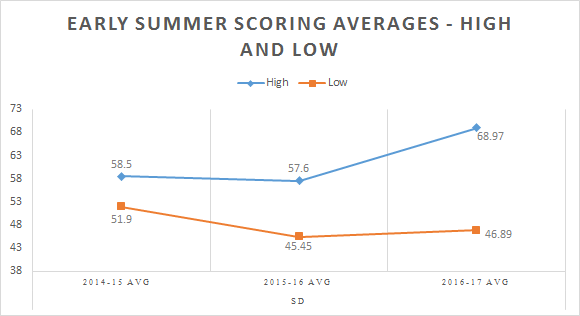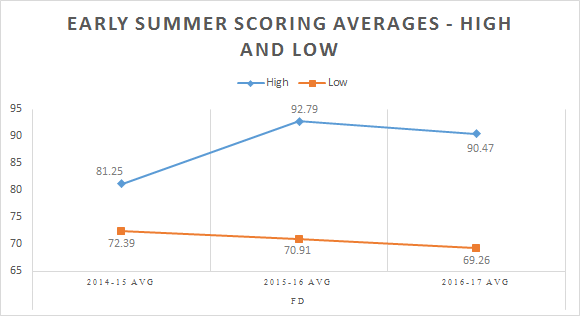The earliest ice dance events of summer — Lake Placid and its championship and international competitions, Minto Summer Skate and the Championnats québécois d’été, or Quebec Summer Championships — are, by near definition, starting points for the long September-March international stretch to come. And by this nature, scores are traditionally mixed at best: star competitors may reap the benefits of skating alongside less established, lesser-scoring compatriots, but the general rule is one of relative modesty. A lower-ranked team may exceed the marks they’ll see at a Senior B, but they won’t find themselves running too far afield of the international or national range they’ll see over the course of a season.
But if applied to 2016’s first summer outings, the season ahead may set some new standards.
Compiled here are the top five scores per segment at each of these three events (combining the Lake Placid Championship and International for 2015 and 2016) — with the caveat that Minto’s field has only once included five or more senior teams in a segment in this span. Fields tend to change from year to year and event to event, though a few couples made repeat appearances, and the scoring swings for those not currently retired or split will be discussed later. The focus here is general scope; by and large, composition within the topmost ranks of these early outings has remain unchanged — the top and lower-placing outliers either competing at elite international level or yet to make an international assignment, and the remaining majority composed of still-developing couples who have or will pick up B assignments and/or have a background on the Junior Grand Prix.
But perhaps more telling is an average of these top and “bottom” scores for each year — offering the starkest look at how these marks have developed:
Level of competition might be one factor in an overall score increase at top and fluctuations at the lower rank, but it’s not at all a full story. In 2014, the top couples at these early event segments included Andréanne Poulin and Marc-André Servant and Élisabeth Paradis and François-Xavier Ouellette — international teams, to be sure, but not among the world’s top scorers; even World Junior champs Kaitlin Hawayek and Jean-Luc Baker were making a senior debut, and were scored accordingly despite taking Lake Placid’s best short dance mark. Piper Gilles and Paul Poirier had perhaps the most established elite senior status of these early competitors, but their score of 60.40 in the short dance at that season’s Minto (in a field of one, no less) is one that takes on a very different meaning viewed in the context of 2016.
Indeed, Gilles and Poirier — who opted to skate only the free dance at 2015 Minto — repeated in the short dance this season, this time competing against three other couples. Their 2016 score of 76.94 reflects not only a more than +16 increase over two years, but is also only 1.95 points behind Meryl Davis and Charlie White’s 2014 Olympic world record and 0.65 points higher than the 2015-16 global season’s best score set by Gabriella Papadakis and Guillaume Cizeron at Worlds. And it’s only one extreme sign of an overall early pattern where this segment is concerned.
Due to a revision in footwork elements, short dance Base Value has increased this season over 2015-16’s. Last season’s SD included two Ravensburger Waltz sequences, each worth a range matching this year’s for the Midnight Blues: 3.2 [L1], 3.8 [L2], 4.4 [L3] and 5.0 [L4]. The Partial Step Sequence offered a base value of 4.10 [L1], 5.60 [L2], 7.10 [L3] and 8.60 [L4]. Combined with twizzles and a lift, the maximum BV for 2015-16’s SD was 29.70.
This year, one Midnight Blues sequence is joined by one PSS (worth the same range as last season), a Non-Touching Midline Step Sequence (assigned the same BV marks by level as the PSS), twizzles and lift. This raises the maximum BV to 33.30, a 3.6 increase from last season — but only a small increase from 2014-15’s short dance BV, when a Paso Doble sequence and its accompanying PSS were each worth a range from 3.0 [L1], 4.0 [L2], 5.0 [L3] to 6.0 [L4]. With a NtMiSt (the BVs for which matched this season’s) and the other elements, this resulted in a 31.70 max BV, certainly providing little explanation for the sharp inflation spotted this year compared with 2014.
Let’s consider the World Championship standard for the short dance, with an achieved minimum TES of 29.00 in the segment a requirement for Worlds qualification since 2012-13 (the ISU has authority to raise or lower the minimum based on additional considerations, but has not yet done so). This minimum must be achieved in international competition (with only the Lake Placid Ice Dance International, held in 2015 and 2016, qualifying among the events we’re considering), but even so, it’s worth taking a look at how many teams have met this standard at these more generously-marked club events.
| Year | Lake Placid | Minto Summer Skate | Quebec Summer Championships |
|---|---|---|---|
| 2014 | Data unavailable | 1 (Gilles/Poirier [30.60]) |
2 (Poulin/Servant [31.60]; Paradis/Ouellette [31.58]) |
| 2015 | 0 (International winners Isabella Tobias/Ilya Tkachenko picked up 27.50) |
0 | 4 (Alexandra Paul/Mitch Islam [32.44]; Madison Hubbell/Zach Donohue [33.16]; Paradis/Ouellette [29.66]; Carolane Soucisse/Simon Tanguay [30.08]) |
| 2016 | 6 (Olivia Smart/Adria Diaz [33.15]; Elliana Pogrebinsky/Alex Benoit [29.57]; Yura Min/Alexander Gamelin [30.10]; Julia Biechler/Damian Dodge [29.15]; Mackenzie Bent/Dmitre Razgulajevs [29.20]; Alexa Linden/Addison Voldeng [30.02]; Championship winners Carolane Soucisse/Shane Firus picked up 27.96) |
2 (Gilles/Poirier [41.34]; Bent/Razgulajevs [32.86]) |
5 (Laurence Fournier Beaudry/Nikolaj Sorensen [36.42]; Soucisse/Firus [33.82]; Marie-Jade Lauriault/Romain Le Gac [33.70]; Tina Garabedian/Simon Proulx-Sénécal [29.74]; Haley Sales/Nikolas Wamsteeker [30.54]) |
Bold = team achieved minimum previously in ISU-recognized competition; italics = team achieved minimum previously at a junior international
Of course, it’s been noted that scores here are mostly meant to stand as their own data; identities of teams have largely been omitted, and many teams have not repeated, with quite a few competing in only one segment of an event — some in only one segment of the 18 considered here. But it’s also worth taking a quick look, for comparison’s sake, at how scores have developed over time for those making repeat appearances in event segment top fives:
| Team | Event | Score #1 | Score #2 | Increase | Percent Increase |
|---|---|---|---|---|---|
| Piper Gilles/Paul Poirier | Minto SD | 60.40 (2014) | 76.94 (2016) | +16.54 | 27.4% |
| Laurence Fournier-Beaudry/Nikolaj Sorensen | Quebec FD | 86.02 (2015) | 93.24 (2016) | +7.22 | 8.4% |
| Danielle Thomas/Daniel Eaton | Lake Placid FD | 78.58 (2015) | 85.80 (2016) | +7.22 | 9.2% |
| Élisabeth Paradis/François-Xavier Ouellette | Quebec FD | 86.64 (2014) | 91.34 (2015) | +4.7 | 5.4% |
| Élisabeth Paradis/François-Xavier Ouellette | Quebec SD | 57.94 (2014) | 58.50 (2015) | +0.56 | 0.97% |
A handful of summer events — Central Ontario Summer Skate/Thornhill, the Dance Chicago Open Championships, BC SummerSkate — remain. Will the new scoring trends also carry on?



